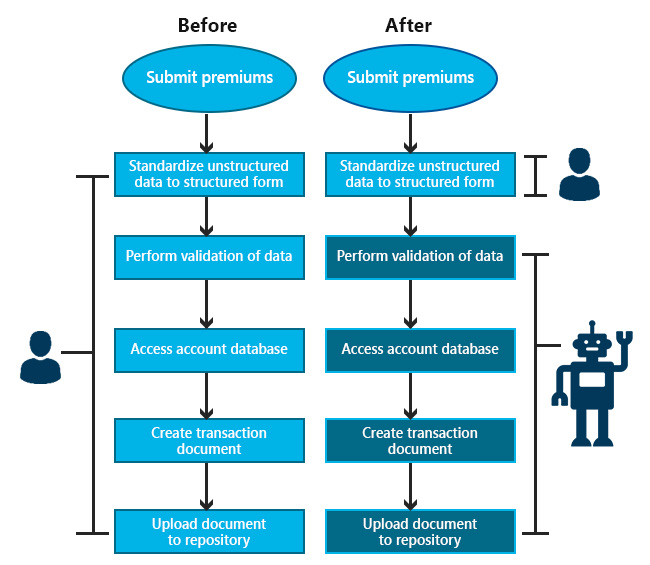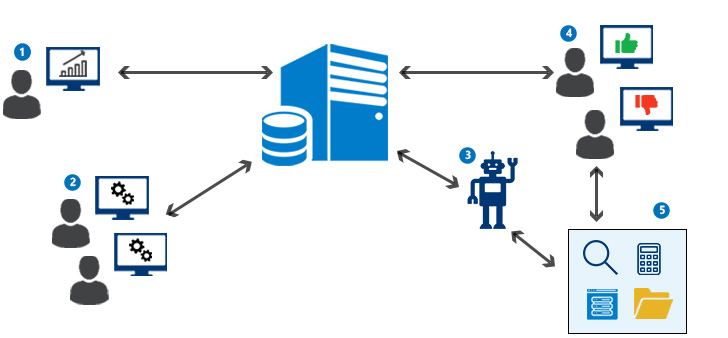Robotic Process Automation (RPA) has become an integral part of the functioning of any company. RPA increases the return on Investment (ROI) and is an easier and quicker implementation process. It improves the core strength of the company and yields high benefits. In the first year, according to the McKinsey survey, the return on investment increased by 30-200%. RPA facilitates cybersecurity, data management and compliance to regulations.

RPA Compared to Traditional Process Transformation Approaches
There must be a harmonious relationship between human staff and the technology to increase benefits. Implementing RPA is easy, but it needs to be planned appropriately and implemented accurately for extracting the best benefits.
- Plan Judiciously:
Any organization needs to create a precise and step-wise plan about what they expect from automation. Team Ampcus works accordingly with the clients’ expectations and eases the process of RPA adoption. We help the clients understand and adopt automation into their everyday work schedule. Planning becomes even more necessary to help change management flow easier. The change management that Ampcus helps the client with brings about a successful organizational change which leads to the digital reformation.
- Choose which process needs to be automated in the organization
Organizations need to choose wisely about which processes they want to automate. Ampcus helps the client decide processes that are best suited for automation. This helps the client to understand the capabilities of the robotic automation process. Processes that need automation vastly can be categorized into four areas:
- Those that need a documented process that is stable, predictable and consistent, all the while defining the operational costs.
- The processes that do not require human intervention at regular intervals and can be easily automated.
- The processes with a high volume of data and are frequently used. These processes generally lead to quick ROI.
- Those processes can be turned into savings based on their accuracy, speed, and cost.

Before and after the Implementation of RPA
- Build Partnership:
When departments work as individual silos in an organization, automation cannot be implemented successfully. All the departments must work as a team and draw on the available resources which can implement automation. Despite the IT department is responsible for software robots, the end-users must be incorporated into the robotic process automation. This is as the end-users possess the knowledge of the functioning of the department and can help the IT department be more accurate through knowledge transfer.
The end-user feedback plays an important role in the RPA as they have the direct effect of this digital change. This feedback helps in improving the RPA as it is an efficient process for information gathering.
- Training as a part of RPA
All employees of different levels need to be made aware and provided guidance about the benefits and the functioning of RPA. Everyone, even those remotely connected to the department must be offered structured and pinpointed guidance about RPA.
RPA creates branches in the workstream and has an impact on the business as a whole. This ramification is the reason that RPA has earned the title of ‘disruptive technology’. It is also important that all the employees are made aware of the uses of automation, identifying the software robots and how they can assist the employees in the completion of projects in their day-to-day tasks and creates a higher value for the project.
Employees need to be categorized into a team of trainers and those who can be trained by this team. Once the team of trainers understands the functionality of RPA they can impart their knowledge to other employees. This knowledge includes the functionality and the limits of automation that enables reasonable expectations maintenance.
- Core team-building
A core team of selected members can be considered as an initial induction of your business as the RPA Centre of Excellence. The entire business must run as a unit, including the manual functioning departments and the automated departments. The core team is a part of the long term plan to maintain this balance. As the members of the core team have a clear view of the initial requirement and the process of induction, they can provide inputs on the efficient implementation of automation. They will be the deciders of ‘which process, when and what for to automate’.
The team can also include experts in the industry outside the organization. It provides an objective understanding of the automation process and becomes a valuable asset when dealing with big projects.
- Critical Test plans
Your business must create two test plans. These include the initial test plan and a fall back plan for the automation process. Different environments are used to build, develop and test the plans created. Required approvals need to be collected before deploying the plans and heading for the working process. Both the test environments should contain all the most recent test data. In the event of any changes after deployment of automation, the fallback plan will aid in re-work and deployment into the working environment.

Robotic Process Automation in Action
1. ‘Process developers’ specify the detailed instructions for robots to perform and ‘publish’ them to the robot controller repository.
2. The robot controller is used to assign jobs to robots and to monitor their activities.
3. Each robot is located in a client environment — which may be virtualized or physical — where it interacts directly with business applications.
4. Business users review and resolve any exceptions or escalations.
5. Robots are capable of interacting with a wide range of applications.
Conclusion:
Every day, 24% of employees’ time is spent on collecting the relevant information from different servers, this adds up to more than a third part of their working days in collecting the concerned data over various systems. RPA makes a significant impact on this activity by turning the time-wasting activities into an easier process. This leads to the quick turnaround time of work, increased productivity of the business and improvement in job satisfaction to the employee.
It is estimated that the robotic automation market is set to reach three billion dollars by 2022. It not only provides a substantial competitive advantage to the competitors but also helps in keeping up and surpassing the cutting edge technologies.




